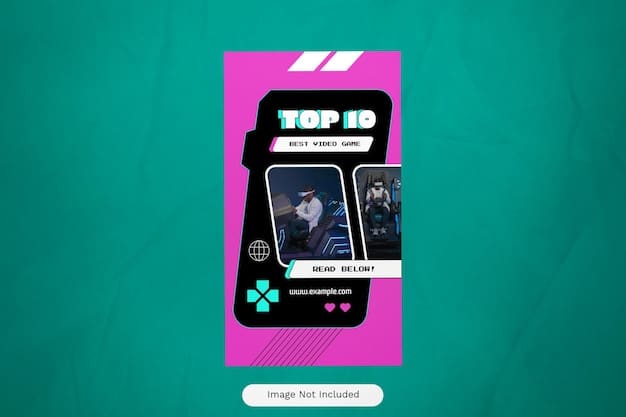TikTok vs Instagram Reels: Best ROI in 2025?

Navigating the evolving landscape of short-form video in 2025, discerning between TikTok and Instagram Reels for optimal return on investment requires a nuanced understanding of their distinct audience demographics, content algorithms, and monetization avenues.
In the dynamic realm of digital marketing, the battle for audience attention is fiercer than ever, with short-form video dominating the landscape. As we look towards 2025, a critical question for marketers is: will TikTok vs. Instagram Reels: Which Platform Delivers the Best ROI in 2025? Each platform presents unique opportunities and challenges, making an informed decision crucial for maximizing your digital marketing spend.
Understanding the Landscape: Short-Form Video Evolution
The rise of short-form video has fundamentally reshaped digital consumption patterns. What began as a niche trend has evolved into a cornerstone of content strategy for brands and creators alike. This format, characterized by its brevity and immediate engagement, caters directly to the shrinking attention spans of modern audiences.
In 2025, it’s not just about producing video; it’s about understanding the intricate ecosystems of the platforms that host them. Each platform, while seemingly similar in format, offers a unique set of tools, audiences, and algorithmic behaviors that directly impact a marketing campaign’s effectiveness.
The Shift in Consumption Habits
Traditional long-form content still holds its place, but short videos have carved out a significant segment of daily media consumption. Users are increasingly drawn to quick, digestible bursts of information and entertainment. This shift necessitates a strategic pivot for marketers, moving beyond static images and lengthy articles to embrace the kinetic energy of video.
- Instant Gratification: Short videos deliver immediate entertainment or information, aligning with modern user expectations.
- High Shareability: Their concise nature makes them highly shareable across various channels, boosting organic reach.
- Accessibility: Both creation and consumption are often simplified, lowering the barrier to entry for users and brands.
- Algorithmic Preference: Platforms actively promote short-form video, giving it preferential treatment in feeds.
This evolution underscores why a deep dive into TikTok and Instagram Reels is not merely academic, but a pragmatic necessity for achieving significant return on investment. The nuances of each platform dictate not just what content to produce, but how it should be strategized and distributed for maximum impact.
The persistent growth trends for short-form video suggest that this isn’t a passing fad but a foundational element of future digital engagement. As platforms continue to innovate, the adaptability of content strategies will be key to long-term success.
TikTok: The Algorithm and Audience Deep Dive
TikTok’s success story is largely attributed to its unparalleled recommendation algorithm, a system so intuitive it often presents content to users before they even realize their interest. This bespoke “For You Page” (FYP) experience is the engine behind its viral potential and a significant factor in its ROI potential for marketers.
The algorithm prioritizes user interaction over follower count, meaning a compelling piece of content from a small creator can go just as viral as one from a mega-influencer. This democratic approach levels the playing field, making organic reach more attainable for brands willing to experiment and innovate.
Understanding the TikTok Algorithm
TikTok’s algorithm is notoriously complex but generally focuses on several key signals: user interactions (likes, shares, comments, re-watches), video information (captions, sounds, hashtags), and device/account settings (language, country, device type). It learns incredibly quickly, adapting to subtle shifts in user behavior. This rapid learning curve means trends emerge and evolve at lightning speed, demanding agility from marketers.
- Interactions: High engagement metrics signal quality content to the algorithm.
- Completion Rate: Users watching a video to its end is a strong indicator of interest.
- Sound Usage: Trending sounds are often tied to algorithmic boosts.
- Niche Exploration: The algorithm excels at pushing niche content to highly relevant users, fostering strong communities.
Audience Demographics and Behavior
While TikTok initially gained traction with Gen Z, its demographic reach has steadily broadened. By 2025, it encompasses a diverse user base, including a significant presence from millennials and even older generations. This expansion means brands are finding diverse audiences ready to engage with authentic, entertaining content.
TikTok users are often looking for raw, authentic, and entertaining content. They value short, punchy videos that are either highly relatable, educational, or simply amusing. The platform thrives on trends, challenges, and user-generated content, making it ideal for viral marketing campaigns and influencer collaborations. Brands that embrace this ethos by creating genuine, less polished content often see the best results.
For ROI, this means TikTok offers unparalleled potential for brand discovery and viral spread, particularly for campaigns that can tap into current trends or create new ones. However, it also demands continuous monitoring and quick adaptation to maintain relevance.
Instagram Reels: Strategy and Engagement Metrics
Instagram Reels emerged as Meta’s direct response to TikTok’s explosive growth, integrating short-form video directly into the established Instagram ecosystem. For marketers, Reels offers the distinct advantage of leveraging an existing, often well-developed audience base and integrating seamlessly with other Instagram features like Stories, Shops, and direct messaging.
The platform’s strength lies in its connection to visually driven communities that Instagram has cultivated over years. Reels benefit from sharing capabilities within feeds and Stories, providing multiple avenues for content discovery beyond the dedicated Reels tab.
Instagram Reels Algorithm Insights
The Instagram Reels algorithm, while sharing similarities with TikTok’s, places a stronger emphasis on a user’s existing network and interests within the Instagram app. It considers factors like shared interests with accounts a user already follows, their past interactions with Reels, and the overall engagement on the video itself.
- User Activity: Likes, comments, shares, and saves on Reels influence future recommendations.
- Information about the Reel: Audio, visual content, and text play a role.
- Interactions with Creator: Users tend to see more Reels from accounts they frequently engage with.
- Relevance to User’s Interests: The algorithm tries to match Reels to a user’s broader Instagram interests.
Unlike TikTok’s “For You” experience often showing content from unknown creators, Reels frequently surfaces content from accounts users already follow or accounts similar to those they engage with. This can lead to a more predictable, but perhaps less virally explosive, organic reach.

Audience Differences and Effective Content
Instagram’s audience tends to be slightly older and more diverse than TikTok’s initial demographic, with a strong presence of millennials and Gen X, alongside Gen Z. Users on Instagram might expect a slightly more curated or aesthetically pleasing form of short-form video. While authenticity is still valued, there’s often a greater appreciation for high production quality and brand storytelling.
Effective Reels content often blends entertainment with aspirational or educational themes. Behind-the-scenes glimpses, product showcases, tutorials, and visually appealing trend participation tend to perform well. The integration with Instagram Shopping also provides a direct path from content to conversion, a significant advantage for e-commerce brands.
For ROI, Instagram Reels can offer a more integrated marketing funnel, leveraging existing follower bases and driving traffic to other Instagram features. Its strength lies in brand building and direct conversions, especially for businesses already thriving on Instagram.
Monetization and ROI Potential: TikTok vs. Instagram Reels
When assessing ROI, it’s not just about reach or engagement; it’s about how those metrics translate into tangible business results, whether that’s brand awareness, lead generation, or direct sales. Both TikTok and Instagram Reels offer distinct avenues for monetization, each with its own set of advantages and challenges in 2025. Evaluating these effectively is paramount for marketers.
Direct Monetization Features
TikTok has rapidly expanded its creator monetization tools, including the Creator Fund, LIVE Gifts, and its in-app e-commerce features. For brands, advertising options range from in-feed ads to brand takeovers and branded effects. The emphasis is often on discovery and viral spread, which can lead to rapid brand awareness if content hits the mark.
- TikTok Shop: Integrated shopping experiences directly within the app, allowing creators and brands to sell products.
- Branded Content Tool: Facilitates transparent partnerships between creators and brands.
- Advertising Suite: Comprehensive options for targeted ad campaigns, including various ad formats and bidding strategies.
Instagram Reels leverages Instagram’s well-established e-commerce infrastructure, including Instagram Shopping tags, product stickers, and checkout features. For creators, direct monetization largely comes through brand collaborations facilitated by Meta’s Brand Collabs Manager or direct outreach. Advertising on Reels is integrated into the broader Meta Ads ecosystem, offering sophisticated targeting and retargeting capabilities.
- Instagram Shopping: Seamless integration of products into Reels, allowing users to tap and purchase.
- Brand Collabs Manager: Tool for brands to discover and connect with creators for sponsored content.
- Meta Ads Platform: Robust ad targeting based on vast user data across Facebook and Instagram.
Evolving ROI Metrics for 2025
ROI in 2025 goes beyond simple impressions and clicks. Marketers must consider contextual relevance, audience resonance, and the true impact on the sales funnel. TikTok’s strength often lies in driving viral brand awareness and fostering community, which can translate into long-term customer loyalty even if direct conversions aren’t immediate. Its discoverability engine is a powerful tool for new brands or products seeking rapid market entry.
Instagram Reels, on the other hand, often provides a more direct path to conversion, especially for brands with an existing Instagram presence. The seamless integration of shopping features, combined with the ability to retarget engaged audiences within the Meta ecosystem, makes it potent for nurturing leads and driving sales within a more controlled environment. Marketers can easily track user journeys from Reel consumption to website visits or purchases.
Ultimately, the “best” ROI depends on the specific marketing objectives. For explosive brand growth and trendjacking, TikTok might offer higher potential. For direct sales, lead nurturing, and leveraging an established visual brand identity, Instagram Reels often provides a more reliable pathway. Many brands will find the most robust ROI by integrating both into a complementary strategy.
Content Strategies for Maximum Impact in 2025
Effective content creation on short-form video platforms requires more than just shooting a quick video; it demands a strategic approach tailored to each platform’s unique characteristics. For 2025, maximizing ROI means understanding not just what to create, but how to authentically connect with distinct audiences on TikTok and Instagram Reels.
Tailoring Content for TikTok
TikTok thrives on authenticity, raw creativity, and a willingness to participate in or initiate trends. Content that feels overly polished or like a traditional advertisement often falls flat. Instead, focus on:
- Trend Participation: Actively monitor and quickly adapt to trending sounds, filters, and challenges. Timeliness is key.
- Authentic Storytelling: Share behind-the-scenes glimpses, personal narratives, or lighthearted takes related to your brand.
- Educational & Entertaining (Edu-tainment): Provide quick tips, life hacks, or explain complex topics in a digestible, entertaining format.
- User-Generated Content (UGC): Encourage and feature content created by your audience. This builds community and trust.
The goal on TikTok is often to go viral and drive brand discovery. Experiment with different video lengths (even shorter than average can work), engage with comments, and use relevant hashtags not just for topic identification, but for trend participation. Brands that are willing to be playful and less corporate often see superior results.

Crafting Engaging Instagram Reels
Instagram Reels, while embracing short-form video, often benefits from a slightly more refined approach that aligns with Instagram’s visual-first ethos. Integration with other Instagram features is a strong advantage.
- High Visual Quality: While authenticity is important, a visually appealing aesthetic often performs well on Instagram.
- Product Showcases (Subtle): Integrate products naturally within lifestyle content, utilizing shopping tags effectively.
- Tutorials & How-Tos: Quick video guides for using products or demonstrating skills.
- Behind-the-Scenes & Day-in-the-Life: Humanize your brand by showing candid moments or daily operations.
- Collaborations & Influencer Campaigns: Leverage established Instagram personalities to reach their engaged audiences.
Instagram Reels can be powerful for nurturing existing followers and driving direct conversions. Leverage Instagram Stories and your feed to promote your Reels, direct message potential customers, and utilize the full suite of Instagram’s business tools. Think of Reels as an extension of your overall Instagram presence, designed to maintain engagement and guide users through your sales funnel.
The most successful content strategies in 2025 for both platforms will emphasize continuous testing, data analysis, and a deep understanding of each platform’s unique user behavior and algorithmic preferences. Remaining agile and responsive to emerging trends will consistently yield better returns.
Challenges and Considerations for Marketers in 2025
While the potential for ROI on both TikTok and Instagram Reels is significant, marketers in 2025 face a new set of challenges and considerations that demand strategic foresight. Navigating these complexities effectively will distinguish high-performing campaigns from those that fall short.
One primary concern is the ever-evolving nature of platform algorithms. What works today might not work tomorrow, requiring constant vigilance and a willingness to adapt. This algorithmic fluidity means that static, set-it-and-forget-it content strategies are obsolete. Real-time data analysis and quick pivots are essential.
Algorithmic Volatility and Platform Changes
Both TikTok and Instagram frequently update their algorithms, sometimes with little warning. These changes can significantly impact content reach and engagement, forcing marketers to constantly re-evaluate their strategies. A strong focus on understanding the core principles of engagement, rather than chasing specific algorithmic loopholes, will yield more consistent results.
- Adapting to Updates: Regularly review platform announcements and industry insights regarding algorithmic shifts.
- Diversifying Content Types: Don’t put all your eggs in one basket; experiment with formats beyond short-form video to mitigate risk.
- Investing in Owned Media: Drive traffic from these platforms to your website or email list to build an audience you control.
Content Saturation and Audience Fatigue
The immense popularity of short-form video has led to content saturation. Users are bombarded with an endless stream of videos, making it harder for brands to stand out. This saturation can lead to audience fatigue, where once-novel formats become commonplace, and users seek fresh, innovative content.
To combat this, brands must prioritize creativity and genuine value. Simply replicating popular trends isn’t enough; adding a unique brand voice or perspective is crucial. Building authentic connections and fostering community engagement can help a brand break through the noise.
Data Privacy and Compliance in a Shifting Landscape
With increasing global scrutiny on data privacy, platforms are continuously updating their policies. Marketers must remain diligent about data collection, user consent, and compliance with regulations like GDPR and CCPA, even when operating within app ecosystems.
The future might see more restrictions on tracking and targeting, which would necessitate a greater reliance on organic reach, compelling content, and contextual relevance over hyper-targeted advertising. Transparency with users about data usage will be paramount for maintaining trust.
Successfully navigating these challenges in 2025 will require a blend of data-driven decision-making, creative innovation, and a strong ethical compass. Brands that prioritize genuine audience connection and adaptability will be best positioned to realize significant ROI from their short-form video investments.
Future Trends and Best Practices for ROI in 2025
As we advance into 2025, the short-form video landscape is far from static. Several key trends are emerging that will shape how brands approach TikTok and Instagram Reels for optimal ROI. Staying ahead of these trends and implementing best practices will be crucial for competitive advantage.
Emerging Trends in Short-Form Video
The push towards interactive and live-stream shoppable content is accelerating. Both platforms are investing heavily in features that allow users to purchase products directly within the video experience. This convergence of entertainment and e-commerce streamlines the path to conversion, offering significant ROI potential.
- Live Shopping Integration: Expect more sophisticated live shopping events and features that combine real-time interaction with instant purchasing.
- AI-Powered Personalization: Algorithms will become even more adept at delivering hyper-personalized content, making niche targeting incredibly effective.
- Immersive AR/VR Experiences: While still nascent, augmented and virtual reality integrations will start appearing in short-form video, creating more interactive and memorable brand experiences.
Authenticity will continue to reign supreme. Users are increasingly wary of overly promotional content. Brands that can master the art of soft selling—integrating their products or services naturally into engaging narratives—will see the best results. This often means empowering creators and leveraging user-generated content.
Best Practices for Sustainable ROI
Achieving sustainable ROI is not about chasing every trend, but about building a robust content strategy grounded in core principles. For 2025, consider these best practices:
- Audience-Centricity: Deeply understand the nuances of your target audience on each platform, tailoring content not just to the algorithm, but to their specific preferences and behaviors.
- Consistency and Quality: Regular posting of high-quality, engaging content helps maintain algorithmic favor and keeps your audience engaged. Quality here means relevance and authenticity, not necessarily high production values.
- Test, Analyze, Optimize: Continuously A/B test different content formats, calls to action, and posting times. Use analytics to understand what resonates and adjust your strategy accordingly. Data-driven decisions are paramount.
- Cross-Promotion: Leverage your presence on one platform to drive traffic to another. Promote your TikToks on Instagram Stories, and vice-versa, to maximize reach and foster a comprehensive digital ecosystem.
- Long-Term Relationship Building: Focus on building a community around your brand and fostering genuine connections. Loyal followers are more likely to convert and become brand advocates, contributing to long-term ROI.
Investing in creator relationships will also be key. Influencer marketing, particularly with micro and nano-influencers, can yield high ROI by leveraging their authentic connection with niche audiences. For brands in 2025, success hinges on adaptability, creativity, and a perpetual focus on delivering genuine value to their audience within the short-form video space.
Measuring and Optimizing ROI on Each Platform
Translating short-form video performance into tangible ROI requires more than just superficial metrics. In 2025, marketers must adopt a sophisticated approach to measurement and optimization, aligning platform-specific data with overarching business objectives. The challenge lies in attributing specific business outcomes to the nuanced engagement styles of TikTok and Instagram Reels.
Both platforms provide robust analytics, but interpreting them through an ROI lens demands clarity on what constitutes a valuable action. Is it brand awareness, direct sales, website traffic, or lead generation? Defining these KPIs before launching campaigns is crucial.
Key Performance Indicators (KPIs) for ROI
While vanity metrics like views are easily accessible, focus on KPIs that directly correlate with business goals:
- Engagement Rate: (Likes + Comments + Shares + Saves) / Views. A high engagement rate indicates content resonance.
- Conversion Rate: Percentage of users who complete a desired action (e.g., website visit, purchase) after viewing your video.
- Cost Per Click (CPC) / Cost Per Mille (CPM): For paid campaigns, these metrics determine ad efficiency.
- Brand Mentions/Sentiment: Track how often your brand is mentioned and the overall sentiment of those mentions, indicating brand health.
- Audience Growth & Retention: While not direct ROI, sustained audience growth points to effective content and future opportunities.
For TikTok, KPIs might lean more towards viral reach, new follower acquisition, and brand awareness, due to its discovery-oriented algorithm. For Instagram Reels, a stronger emphasis might be placed on conversion events, product page views, and direct sales, given its integrated shopping features and existing user base that might be further down the purchase funnel.
Attribution Models and Optimization Strategies
Effective ROI measurement requires sophisticated attribution models. While last-click attribution is simple, it often understates the role of awareness-driving platforms like TikTok. Multi-touch attribution models, which consider all touchpoints in the customer journey, provide a more complete picture.
Optimization for TikTok:
- Content Refinement: Analyze which video formats, sounds, and trends drive the highest engagement and replication rates.
- Audience Deep Dive: Use TikTok’s audience insights to fine-tune future content based on what resonates with your specific demographic.
- Campaign Iteration: Run multiple short campaigns with varied content to quickly identify what goes viral and scale winning ideas.
Optimization for Instagram Reels:
- Call-to-Action (CTA) Testing: Experiment with different CTAs and placements to see which drives the most desired actions (e.g., “Shop Now,” “Learn More”).
- Integration with Shopping Features: Continuously optimize product tags, stickers, and links to streamline the purchasing process.
- Audience Segmentation: Leverage Instagram’s detailed audience targeting for paid Reels campaigns to reach highly specific user groups.
Ultimately, optimizing ROI on both platforms involves a cyclical process of planning, execution, measurement, and refinement. It’s an ongoing commitment to understanding your audience, adapting to platform changes, and translating creative content into measurable business success.
| Key Metric | Platform Advantage |
|---|---|
| 🚀 Viral Reach | TikTok’s algorithm excels at rapid content discovery and viral spread. |
| 🛍️ Direct Conversion | Instagram Reels benefits from integrated shopping features and user familiarity. |
| 👥 Audience Engagement | Both platforms foster high engagement, but with distinct content expectations. |
| 📈 Brand Building | Instagram provides stronger cross-platform integration for holistic brand presence. |
Frequently Asked Questions About TikTok vs. Instagram Reels ROI
Short-form video aligns with shrinking attention spans and mobile-first consumption habits. Its quick, digestible format leads to higher engagement rates and greater shareability, making it an indispensable tool for reaching and captivating modern audiences across diverse demographics in 2025.
TikTok’s algorithm prioritizes content virality and user interaction for its “For You Page,” surfacing content from diverse creators. Instagram Reels leverages a user’s existing network and interests within the broader Instagram ecosystem, often showing content from accounts they follow or interact with, leading to more curated discovery.
TikTok generally offers a higher potential for viral brand awareness due to its discovery-focused algorithm, which can push content from new accounts to a massive audience. If the goal is rapid brand recognition and trending, TikTok often holds the edge, especially for authentic, trend-driven content.
Yes, both platforms offer sales capabilities, but Instagram Reels, with its seamless integration of Instagram Shopping features, often provides a more direct and familiar path for e-commerce conversions, especially for brands with existing product catalogs. TikTok has its own growing e-commerce tools, but may require a different strategic approach.
TikTok favors authentic, raw, trend-participating, and often humorous content for broad viral appeal. Instagram Reels tend to perform well with visually aesthetic, curated, aspirational, or educational content that integrates well with the brand’s overall Instagram presence, often leveraging existing follower relationships for engagement.
Conclusion
As we navigate the evolving digital marketing landscape of 2025, the question of whether TikTok or Instagram Reels delivers the best ROI isn’t about choosing one over the other, but rather understanding their distinct strengths and how they align with specific marketing objectives. TikTok excels in viral discovery and rapid brand awareness through its unique algorithm and authentic content culture. Instagram Reels, leveraging its established ecosystem, offers stronger integration for direct conversions and brand building within a more visually curated environment. The most potent strategy for marketers in the coming years will likely involve a complementary approach, tailoring content and leveraging the unique advantages of each platform to create a robust and multifaceted short-form video presence. Continuous adaptation, data-driven optimization, and a commitment to genuine audience connection will ultimately define success in this dynamic arena.





